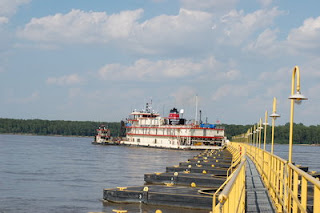I noticed while searching the census records of the early 1900's that several men, including some of our Bourgoyne ancestors, worked on a "dredge boat". So I became curious- just what is a dredge boat and what does it do? Of course, the first thing I usually do when I'm curious about something is "google it" (sure beats the days when I had to drive to the library to look something up). This was the results-
Rivers carry suspended sand and soil along with them as they flow toward the ocean. The higher the water velocity, the greater the speed of the water, the greater its energy and capacity to move soil, sand, and even rocks along with it. When the velocity of the water decreases, it loses energy and the non-floating materials drop to the bottom of the river channel.
As stream or river velocity slows, heavier materials, like sand and gravel, will settle out first. In rivers and streams that experience periods of high flow during the year, the formation of sand or gravel bars is common. Because they are so light, silt and clay particles do not settle out until the river has lost most of its energy and velocity. In still water, harbors, and backwater areas, like bayous and oxbows, silts and clay will settle out.
Material that falls to the bottom of a liquid is called sediment. If enough sediment deposits to build a shallow spot on the river or ocean bottom, it forms shoals. A shoal in a navigation channel that causes the bottom to become shallower than is shown on nautical charts is a safety hazard. If a vessel grounds, or strikes the shoal, the vessel and its contents may be damaged. In serious situations, the environment can be damaged if the ship's cargo is spilled into the waterway.
Underwater excavation is called dredging. After the initial excavation needed to establish a channel, the periodic dredging that must be done to keep it clear and safe for navigation is called maintenance dredging. Once sediments are dredged from the waterway, they are called dredged material.
A dredge is a machine that scoops or suctions sediment from the bottom of waterways or is used to mine materials underwater. People have been dredging channels in one way or another since primitive people began to irrigate crops. Until the early 1900s, dredges were crude and barely effective in keeping channels and harbors clean. Keeping the dredge in position in the channel, knowing how deep a channel was being dug, and even making accurate surveys of the completed channel, were a mixture of art and science. Experienced dredge captains and hydrographic surveyors (surveyors of the underwater topography) were able to produce remarkably good results, given the difficulty of their job.
Dredging is necessary to maintain our nation's system of waterways. Nearly 400 million cubic yards of material is dredged each year. Consequently, about 400 million cubic yards of material must be placed in approved disposal sites or else used for another environmentally acceptable purpose.
The above information was obtained from the U.S. Army Corps of Engineers educational web site. And here are some photos of various dredge boats that have helped clean up the mighty Mississippi River:
 |




No comments:
Post a Comment